Going from Gothenburg to Tokyo by train is one of the longest routes available, as it spans across nine time zones and seven countries. The largest part of the journey is the Trans-Siberian railway from Moscow to the Pacific, the world’s longest railway with 9238 kilometers.
Leaving Sweden
For some reason it felt like a fun idea to cross a third of the world. A 12000 kilometer journey by train, ferry, horse, bus, Shinkansen, tram, subway, swan boat, taxi and on foot.
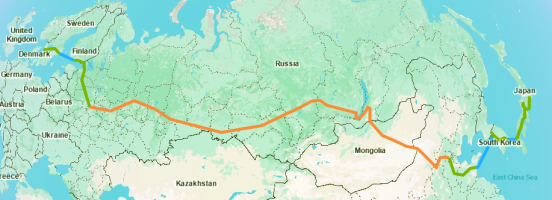 Across the globe.
Across the globe.
It was a magnificent day for departure with clear skies and 11 degrees Celsius. We donned our heavy backpacks at the Central Station in Gothenburg and boarded the first train of many to come.
We arrived in Stockholm a few hours later and made our way to the harbor where the ferry awaited to take us across the Baltic sea.
Back in Helsinki
Woke up as the ferry arrived in Helsinki, the capital of Finland. I hadn’t been there for several years, but the harbor looked the same as I remembered and it felt good to be back.
We took a tram to the Central Station where we locked up the backpacks in security boxes and went for a walk across the city in the chilly winds. Visited a few unexpected places, such as the Temple church with an unusual underground setting.
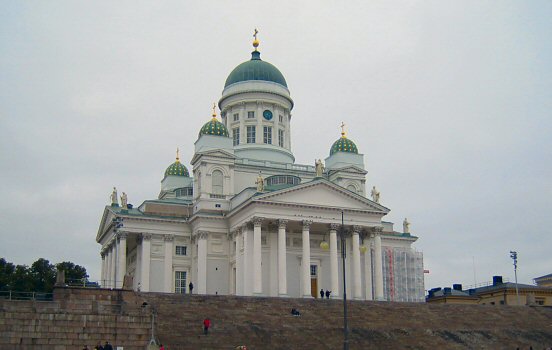 The Helsinki cathedral at Senate square.
The Helsinki cathedral at Senate square.
The train for Moscow departed in the evening from track 8. Shared cabin with a friendly Russian couple who told us that a plane had supposedly hit the Trans-Siberian railway near Perm where we would pass in a few days. I made my way to the restaurant carriage of the train and talked with a Russian guy who shared some additional tidbits of the accident.
As we got closer to the border, we had to stay put in the cabin while the Finnish and Russian border patrols boarded the train and searched in vain for my secret stash of chocolate.
- Related blog post: Isolation on Trans-Siberian railway
Exploring Moscow
The train arrived early morning in Moscow at one of the nine train stations. I found bliny (pancakes) with black coffee for breakfast and rolled off into the city.
We passed the Gorky park and had a look at the abominable statue of Peter the Great, one of the tallest outdoor sculptures in the world. It’s located in the middle of Moscow river, near the Cathedral of Christ the Saviour which was once torn down with explosives by order of Stalin and turned into the world’s largest swimming pool. This country is full of fascinating and bizarre stories, I wish I had time to explore them all.
Had some Solyanka soup and took a metro to the Red Square, which was beautifully lit and the red ruby star of the Spasskaya tower was shining brightly in the night.
 St Basil’s Cathedral at Red Square.
St Basil’s Cathedral at Red Square.
I entered into the dark of Vladimir Lenin’s tomb where his embalmed body has been on display since his death in 1924. Next stop was to get into the Kremlin, where I had a look at the old cathedrals and beautiful Fabergé eggs.
- Related blog post: Red Square of Moscow
Into the unknown
A few days later, as the darkness fell over Moscow, we grabbed our heavy backpacks and headed for Yaroslavsky station. It is the official start of the Trans-Siberian railway, the longest train journey in the world. I remember once hearing Henry Rollins explain how utterly lost he felt when he arrived on this massive station with all these weird signs in Cyrillic alphabet.
At an underground market I bought supplies for surviving the long train ride. The distance from Moscow to Beijing is 7800 km and provisions may be scarce along the way. The train arrived on time and we boarded what would be our home for the next five days. Da svidaniya, Mockba!
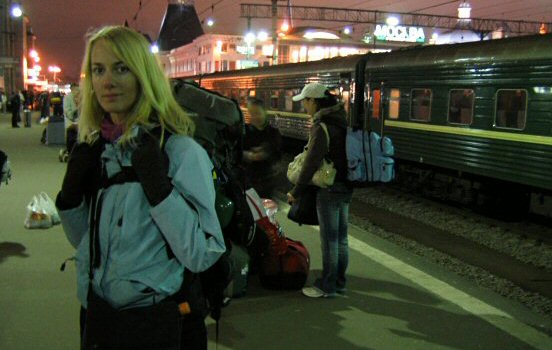 Leaving Moscow from Yaroslavsky station.
Leaving Moscow from Yaroslavsky station.
The next morning the train stopped in Balezino, where I bought some edible stuff for breakfast from the lovely babushkas on the platform. We arrived in Perm during the afternoon but there was fortunately no sign of any plane crash.
The friendly Russian next door invited me to his cabin for snacks. He had bought five liters of beer in Perm and was eager to empty it along with smoked fish, cheese and cucumber.
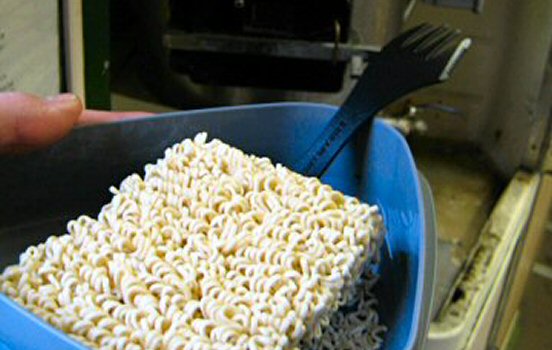 Making noodles for supper at the samovar. A touch of glamor.
Making noodles for supper at the samovar. A touch of glamor.
We arrived at Omsk in the morning. Each carriage has a samovar of boiling water, which became the meeting point for sleepy travelers on the train. Dried noodles are not really my favorite food but they are adequate for survival. Another glorious day on the Trans-Siberian.
I remember reading Ryszard Kapuscinski’s book “Imperium” where he described his trans-siberian experience in 1958. Crossing Siberia 50 years ago during wintertime was certainly no picnic, but times have fortunately changed for the better.
The train briefly stopped in Novosibirsk where the train attendants refilled the coal supply from a truck. By now it started to feel like we had passed the edge of civilization, with nothing but utter darkness outside the window as we rushed east into the unknown.
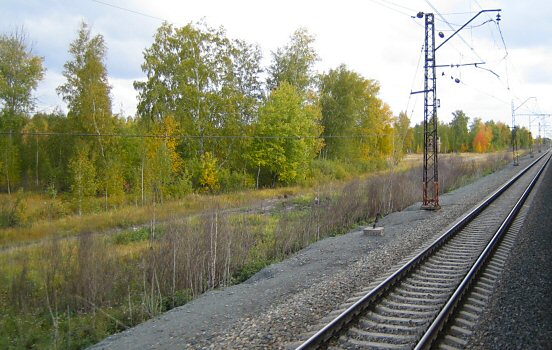 It’s a good thing if you love birches.
It’s a good thing if you love birches.
Bought bread in Krasnoyarsk and watched old women walk among the ancient houses framed by beautiful autumn leaves. I spent some time listening to my iPod while the endless birch forests of Siberia passed outside the window.
David Bowie enjoyed traveling as a way to come up with new ideas, but since he was afraid of flying, he had to use other means of transport. In 1973 he took the Trans-Siberian to get home after his tour in Japan.
“I could never have imagined such expanses of unspoilt, natural country without actually seeing it myself, it was like a glimpse into another age, another world, and it made a very strong impression on me. It was strange to be sitting in a train, which is the product of technology — the invention of mankind, and travelling through land so untouched and unspoilt by man and his inventions.”
— David Bowie, 1973
Best stop of the day was Ilanskaya, where I managed to lay my dirty hands on homemade pancakes with cottage cheese on the platform. A delicious bargain, bless that old lady! Also found some mystery meat with Borsjt soup. Not particularly tasty but hey, it could be worse.
There are 11 time zones in Russia and the Trans-Siberian pass through seven of them, but the train is always on Moscow time. Despite this fact I found it quite easy to lose track of time on board the train.
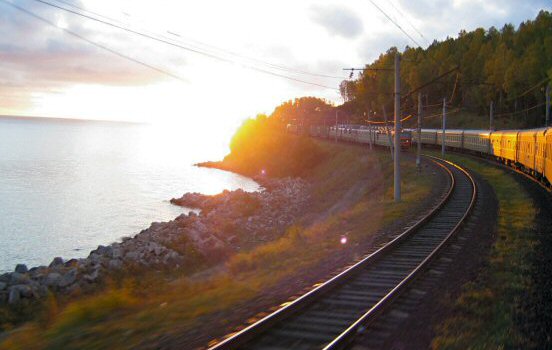 Sunrise at Lake Baikal.
Sunrise at Lake Baikal.
We arrived at Irkutsk early in the morning, once the most cosmopolitan city of Siberia. I admired the beautiful sunrise over Lake Baikal, the deepest lake in the world which holds 20 percent of the world’s total fresh water. It’s also the oldest lake in the world, more than 25 million years old. Probably a perfect place to hide a spaceship or two.
The train stopped in Slyudyanka and I remembered a travel blog I read many years ago, where two young men had jumped off the train at this spot. They ran to the lake to splash themselves with the supposedly holy water for a few seconds, but quickly realized that it would be quite bad to be left in Siberia with all their belongings still on the train, so they ran back faster than Olympic sprinters.
As the train started to go south towards Mongolia the forests were replaced by low grass in the area southeast of Lake Baikal, which was once the home territory of Genghis Khan. The temperature increased and we enjoyed beautiful views of the Goose Lake.
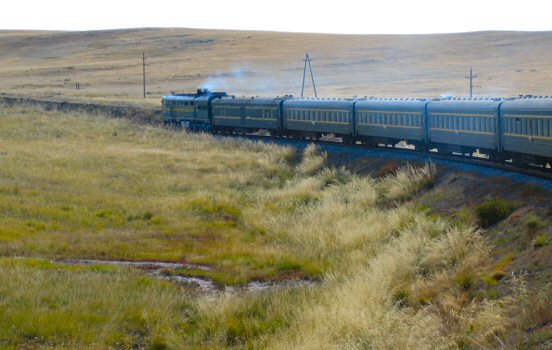 Going south towards Mongolia.
Going south towards Mongolia.
We arrived at the border station Naushki in the evening. First they took our passports, then we had to wait two hours before getting back on the train. Two more hours of waiting for the Russian customs to arrive with dogs, carefully searching all the luggage before getting our passports back. Since the toilets were locked during the seven hour stop, we had to bribe the provodnitsas to use the facilities.
Just as soon as we thought we were done with the border struggle, the Mongolian officials came onboard in camo uniforms and went through everything again.
Good morning Mongolia
In the morning I started to see white Ger tents scattered across the plains outside the window. The train got closer to the capital of Mongolia and the first person I saw in Ulaanbaatar was sitting along the railroad, taking a dump. Welcome to Mongolia, I guess.
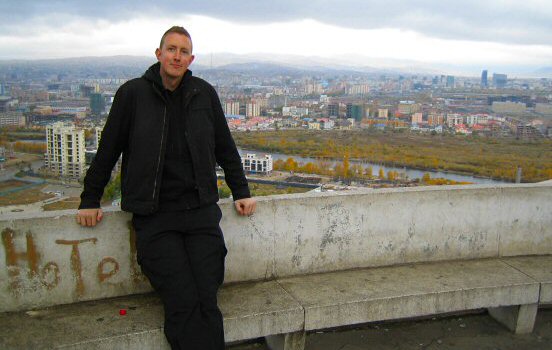 Scouting Ulaanbaatar.
Scouting Ulaanbaatar.
Ulaanbaatar has the lowest average temperature of any national capital in the world, which became painfully obvious as soon as I got off the train. The city is also second most polluted city in the world, but after five days on a train it felt wonderful to breathe some cold air and stretch my legs.
I changed my Russian rubles into Mongolian tögrögs and went up the Zaisan hill to get a view of the city.
- Related blog post: Dawn in Ulaanbaatar
Mongolia is the most sparsely populated independent country in the world and there is less than 1500 km of asphalt roads, but fortunately we found one of them and drove east past ruins of small towns where Soviet soldiers used to live.
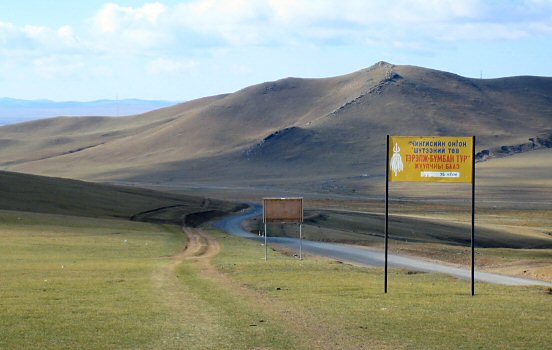 On the road in Mongolia.
On the road in Mongolia.
Tired and dirty, we arrived in the beautiful Terelj area where we stayed in a traditional Ger tent. After five days on the Trans-Siberian train, the freezing tent felt like pure luxury and I slept better than on the train despite various animal sounds just outside the tent.
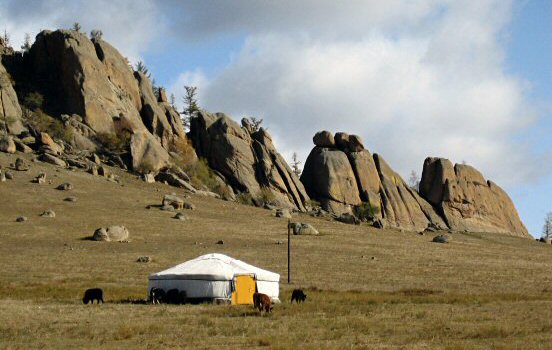 Traditional Ger tent in Gorkhi-Terelj.
Traditional Ger tent in Gorkhi-Terelj.
We started the next day with Airag, fermented mare’s milk. It is often referred to as nomad whiskey but tasted more like sour-cream. After that we were brave enough to jump into the saddles and ride off into the beautiful landscape, where the autumn colors of the trees were gracefully mixed with the gray mountains.
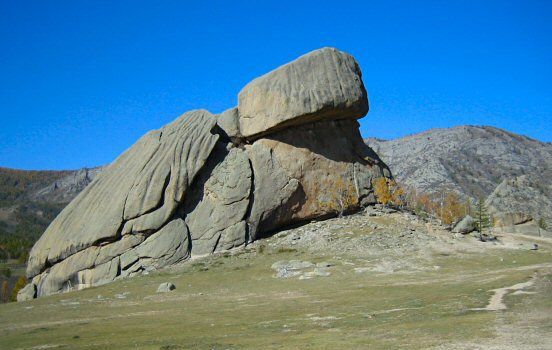 Riding to the turtle rock.
Riding to the turtle rock.
During the days in the valley we went horseback riding, saw crazy climbing goats, wild yaks and two-humped Bactrian camels.
- Related blog post: Tent heating in Mongolia
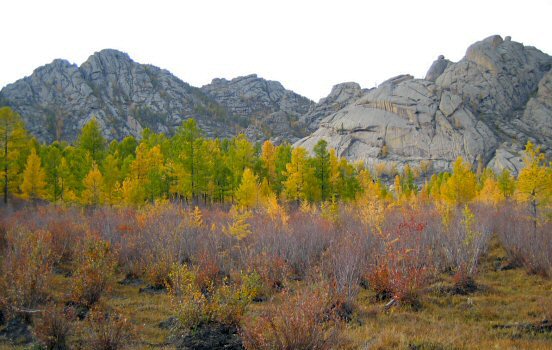 Beautiful autumn leaves.
Beautiful autumn leaves.
At nighttime I stood alone in pitch black darkness and watched the stars of the Milky Way, totally free of light pollution.
Through the Gobi desert
The valley was peaceful and relaxing, but after freezing my nose off in the tent for several nights it felt rather nice to return to the smelly old train. We headed south through the Gobi desert, continuing the Trans-Siberian railroad journey.
However, the view of endless Gobi desert became utterly boring more quickly than I had anticipated. The word “gobi” is a Mongol term for desert steppe. I remember reading the Yule-Cordier edition of The Travels of Marco Polo and how he described the Gobi desert, “it consists entirely of mountains and sands and valleys, there is nothing at all to eat”.
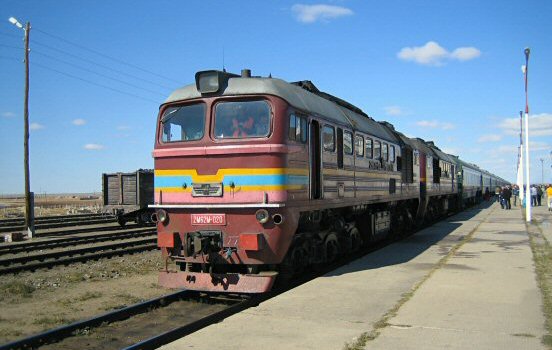 Arriving in Choir.
Arriving in Choir.
We arrived in the the ghost town called Choir and had a look at the statue of the first Mongolian cosmonaut, Jügderdemidiin Gürragchaa, standing in the square. I must admit that I have seen livelier towns.
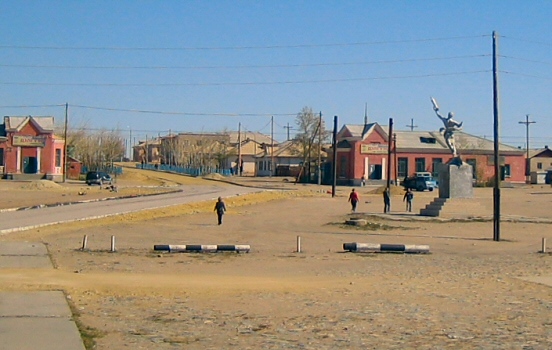 Exciting times in Choir.
Exciting times in Choir.
After a few more hours of dust we rolled into Sainshand, probably the most depressing town I’ve ever seen, located in the outskirts of the Gobi desert. I surveyed the barren landscape and wondered how anyone could survive there.
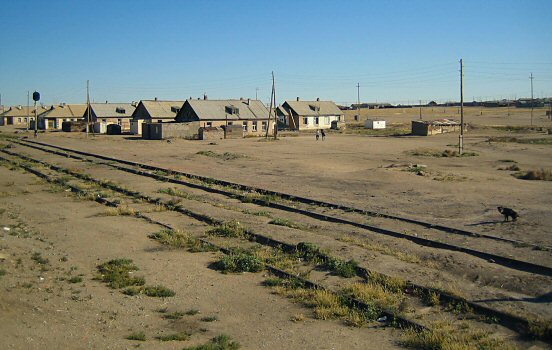 Sainshand, Mongolia. Bring your own.
Sainshand, Mongolia. Bring your own.
Later in the evening we arrived at the border station Zamyn-Üüd. Since Chinese railroads operates on a narrower gauge than Mongolia, the bogeys had to be changed. The entire train wagons were lifted into the air with us being still onboard, an interesting feat of engineering.
We finally crossed the border into China past midnight.
Business in Beijing
As we crossed northern China, beautiful mountains began to appear.
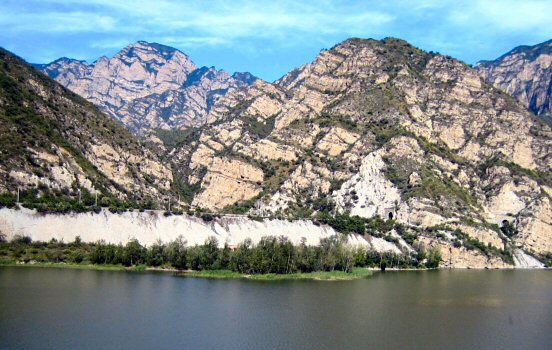 View from the Trans-Siberian, rolling through northern China.
View from the Trans-Siberian, rolling through northern China.
After brief stops in Zhangjiakou and other places we arrived at Beijing central station in the afternoon. It felt rather good to finally get off the Trans-Siberian, despite the heat and heavy backpacks. This far we had covered 10 000 kilometers of railroad from Helsinki to Beijing, not including the initial train ride across Sweden.
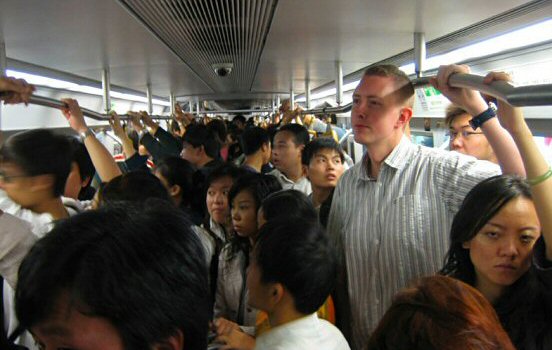 I blend in like a chameleon in the Beijing subway.
I blend in like a chameleon in the Beijing subway.
The next day we went to the Tiananmen Square, the largest square in the world. I tried to envision the atrocities committed here in 1989 as we crossed the square and reached the mausoleum of Chairman Mao, where I saw his embalmed remains on display just like Lenin in Moscow.
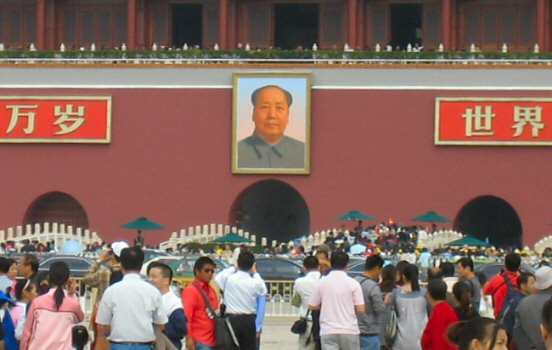 Would you buy a used car from this man?
Would you buy a used car from this man?
We quickly got lost in the traditional hutong alleys. During the last 50 years a lot of the hutongs have been demolished to make way for modern buildings.
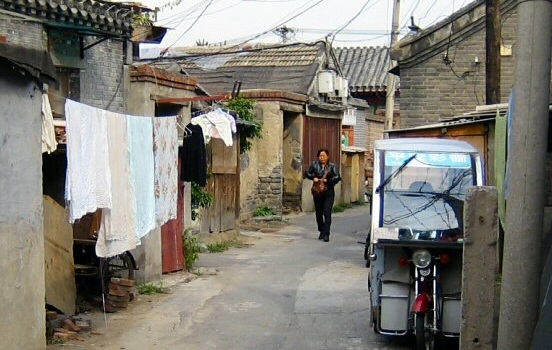 A hutong in Beijing.
A hutong in Beijing.
It’s not every day when you get to climb the Great Wall, but this was such a day. It goes up and down hill after hill, and some of the slopes are quite steep. The peak stretch is estimated to have been 6700 km, but a few of the hills were enough for me.
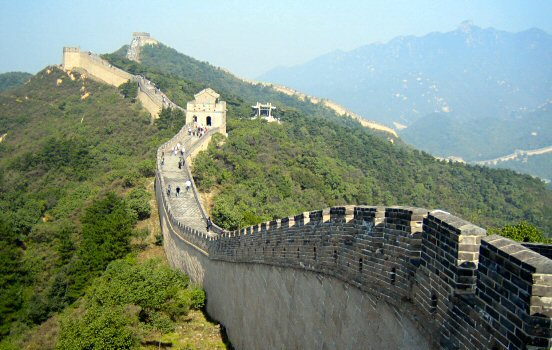 Another brick in the wall.
Another brick in the wall.
- Related blog post: Forbidden City in Beijing
Going to Qingdao
Got up at 4 AM and went off to the western train station of Beijing, which turned out to be ridiculously large. We boarded a speed-train which took off in 242 km/h according to the display, a number that instantly inspired me to listen to Front 242 on my iPod.
It was a rather uneventful trip and we arrived at the train station of Qingdao in the afternoon. After leaving the backpacks at a hotel we went on a holy quest for food and coffee. Qingdao has 8 million citizens but felt like a relaxed small town after the chaotic streets of Beijing.
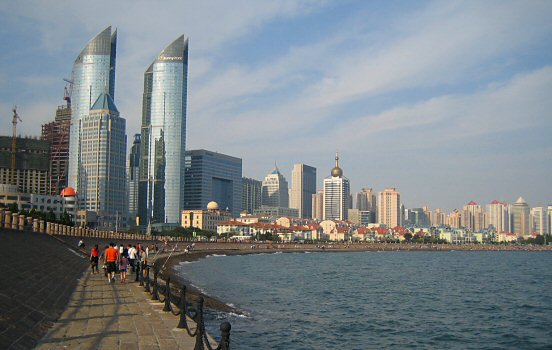 The waterfront of Qingdao.
The waterfront of Qingdao.
As we got down to the May Fourth Square on the waterfront we noticed there were tons of people there, as it turned out to be the “59th birthday of the Republic of China”. A lot of kites were in the air and the evening ended with fireworks.
 Merry street food vendors.
Merry street food vendors.
Crossing the Yellow Sea into South Korea
We took a bus to the ferry terminal, where everyone were staring their eyes off at us. I guess not too many Westerners use this route. The ferry departed in the afternoon and provided a spectacular view of the Qingdao skyline at sunset as we drifted east across the Yellow Sea.
The food we found on-board was almost as bad as the Beijing dishes, which is a most impressive accomplishment.
 Crossing the Yellow Sea.
Crossing the Yellow Sea.
Next morning the ferry entered the harbor of Incheon through the largest sluice gate I’ve ever seen. Immigration went pretty fast for a change and we took a cab to central Seoul where we stayed at some kind of family hostel.
Starved as usual, we found some sort of restaurant near Hongik University where we left our shoes at the entrance and seated our weary butts on floor cushions. After the usual confusion, I got some kind of mystery meat. Where is the Star Trek universal translator when you need one?
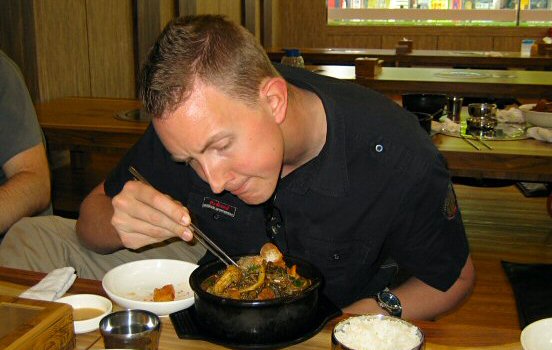 I think I remember this scene from “Alien”.
I think I remember this scene from “Alien”.
We spent the afternoon strolling along Cheonggyecheon, a beautiful water stream running for six kilometers along the skyscrapers of downtown.
Passed through various markets and sometimes felt my appetite go down the drain as the fishes stared back at me.
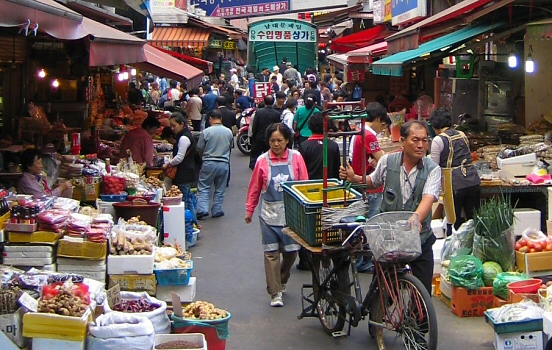 Daily life at Namdaemun market.
Daily life at Namdaemun market.
We later caught a tram to Dongguk and went for a long walk uphill to Seoul Tower, where a large crowd had gathered. It was the 50 year anniversary of the cease fire with North Korea, so fireworks began to appear over the skyscrapers downtown.
 Zombie fishes at Namdaemun market.
Zombie fishes at Namdaemun market.
Went for a walk to the beautiful Changdeokgung palace, featuring 400-750 year old trees as well as the oldest stone bridge in Seoul, built in 1411. The rooftops had figures which reminded me of the ones I saw in the Forbidden City of Beijing a week earlier. Unfortunately most of the old buildings had suffered severe fire damage during the Japanese invasion in 1592.
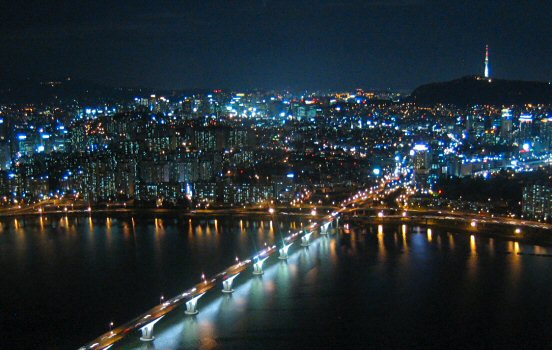 Seoul Tower looming over the Han river.
Seoul Tower looming over the Han river.
The next day we went north and entered the DMZ of the 38th parallel, the infamous area separating North from South Korea. Created in 1953, the DMZ is the world’s most heavily fortified border with a 155 mile long military demarcation line. Seven million Korean families are still separated by the DMZ, a sad story.
From a hilltop I looked into North Korea with binoculars, seeing their flag shaking defiantly in the wind.
- Related blog post: A day of war in Seoul
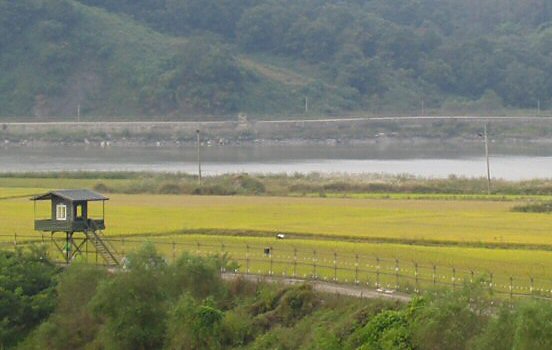 Korean Demilitarized Zone border. Watch your step.
Korean Demilitarized Zone border. Watch your step.
Going south to Busan
We boarded a KTX train from Seoul station and crossed the southern peninsula with a nice speed of 300 km/h.
Reached the town Busan in the afternoon. After some difficulties we at least managed to get something edible in exchange for money. The town turned out to be a really boring place, so I gladly boarded the ferry which would take us across the Korea Strait to Japan.
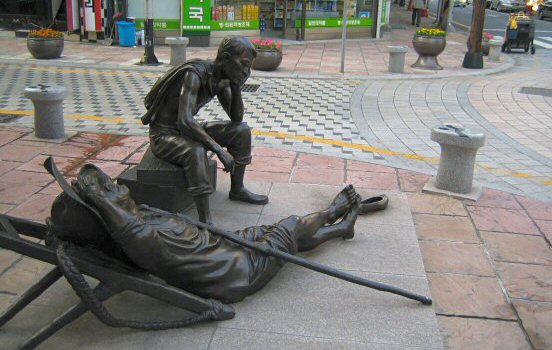 Even the statues are bored in Busan.
Even the statues are bored in Busan.
Arriving in Japan
I got up at dawn just in time to see the sunrise over the coast of Japan, the land of the rising sun. The ferry arrived in the town of Shimonoseki.
As we were washed ashore like smelly gaijins, I kind of expected the same harsh treatment as Anjin-san and his crew received in James Clavell’s “Shogun”, but the locals turned out to be extremely friendly. I tried to my poor vocabulary at the girl behind the counter in a coffee shop, who gave me a large giggle and a small coffee. I would have preferred a small giggle with a large coffee, so I need to practice my Japanese.
We walked to the train station and got on a small train to Kokura, where we changed to Shinkansen. This is the world’s fastest train for regular traffic, with speeds up to 300 km/h. The trains are clean and comfortable, and the conductor respectfully bowed before entering the train carriage.
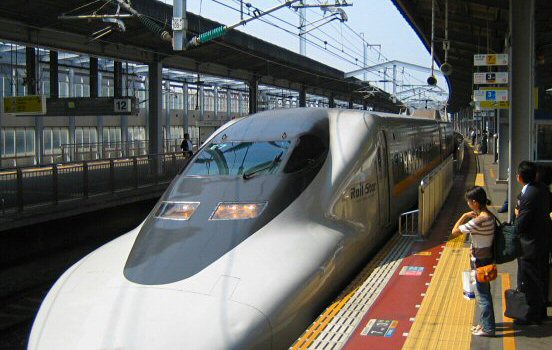 Boarding the Shinkansen at Kokura train station.
Boarding the Shinkansen at Kokura train station.
Later that day we arrived in sunny Hiroshima. Payed 150 yen for a ticket and boarded a tram which took us to Dobashi where we found a hostel, complete with futon mattresses on hard tatami mats. I slipped into a very small yukata robe and headed for the large common bathing room in the basement.
Big in Japan
“Big in Japan” by Alphaville was the song in my head this morning as I walked alone through the streets of Hiroshima and attracted a lot of attention due to my height. I felt like a sleepy Godzilla and began to wonder if my head was visible over the rooftops, but unlike the Chinese, the attention was handled in a very discrete and polite way by the Japanese.
I went for a stroll through the solemn Peace Park, which was once the busy downtown district of Hiroshima before the atomic bomb detonated on August 6, 1945. Walked past the eternal fire and up to the “A-bomb Dome”, one of the very few structures that survived the blast.
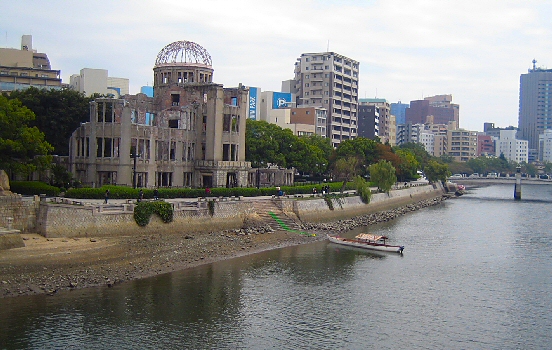 A-bomb Dome in Hiroshima, as seen from Aioi bridge.
A-bomb Dome in Hiroshima, as seen from Aioi bridge.
The intended target was the Aioi bridge, but the bomb drifted slightly off course by the wind and detonated above the building. Most of the walls managed to withstand since the blast came from directly above, but almost every other building in Hiroshima was erased.
We boarded a ferry to the island Miyajima. It has been worshipped as a divine area and features the well-recognized red torii gate standing in the water. I enjoyed the tranquil atmosphere of the island and tried some kind of strange waffles at a vendor along the village streets.
- Related blog post: The gate of Hiroshima
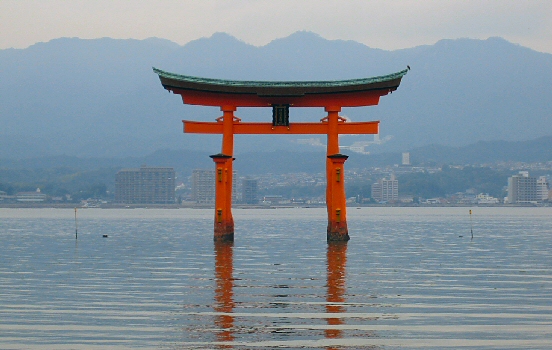 Torii at Miyajima island.
Torii at Miyajima island.
Eastbound to Kyoto
We caught a tram to the train station where I bought some maki for breakfast before boarding the Shinkansen.
“One of the pleasures of Japan is the long journey taken on a fast train.”
— Anthony Bourdain
A short journey later, we arrived at the train station of Kyoto which turned out to be a a large 15-floor building, the second-largest train station in Japan.
We walked some blocks north of the station before finding our ryokan, which is a sort of traditional Japanese inn. The grumpy old manager was very strict about us having to wear special slippers inside. Got a nice room with futons, tatamis and walls of rice paper. The only thing missing was a ninja outside the sliding doors.
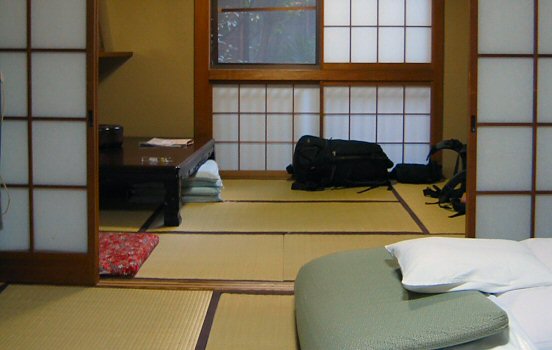 Staying at a traditional ryokan in Kyoto.
Staying at a traditional ryokan in Kyoto.
In the evening we went north to explore the seedy Gion district, walking all the way to river Takano. By a back alley we slipped into the Pontocho area and saw Geishas passing by silently in the narrow alleys. This is a place where you really feel that you’re not in Kansas anymore.
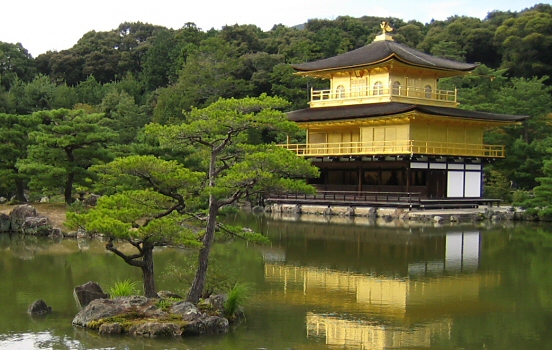 Rokuon-ji Temple in Kinkaku, Kyoto.
Rokuon-ji Temple in Kinkaku, Kyoto.
There’s a lot of ancient temples in Kyoto since it was spared during the WW2 bombings. We took a bus to Kinkaku-ji, an area well-known for the magnificent golden temple Rokuon-ji situated in a Kyoko-chi mirror pond.
Had green tea in a garden and with renewed strength we walked westward towards one of my prime destinations, the Ryoanji temple with a 13th century zen garden. A beautiful place of tranquility. Staring at a bunch of rocks may not sound too sexy, but I assure you it’s well worth the visit.
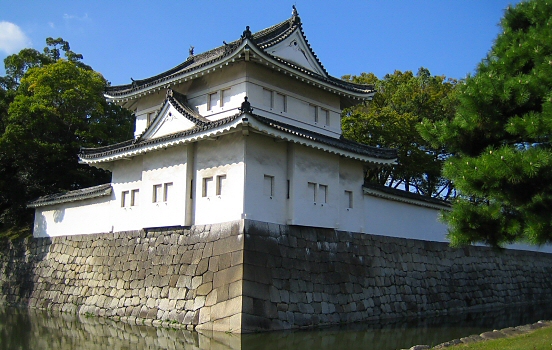 Nijo-jo castle.
Nijo-jo castle.
It is a strange sensation to stroll in a Japanese town as a six-foot-five gaijin, a foreigner excluded from the language and everyday rituals that everyone within sight silently obeys.
- Related blog post: Alone in Kyoto
Into the Japanese alps
Early checkout and a short walk to the Kyoto train station, where we boarded yet another train which soon rolled through the misty Japan Alps. Beautiful valleys and deep gorges went past outside the window for hours as the train winded its way up the hills.
We finally arrived in Takayama, a traditional village with several sake breweries. Went across the Kaji-bashi bridge into the Old Town where we dodged into a place which served something that vaguely reminded of coffee.
We later found a place which served the local Hida beef from the Hida highlands, which was very nice but almost as expensive as the infamous Kobe beef.
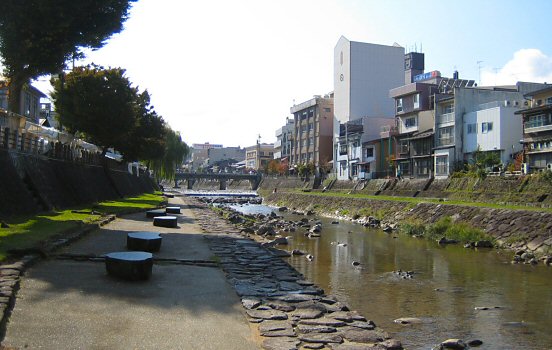 Morning walk along the river Miyagawa in Takayama.
Morning walk along the river Miyagawa in Takayama.
The next morning I went out for a stroll at the morning market along the river Miyagawa, before the train arrived and we went south.
Had a brief stop in Mishima, close to the spectacular Mt Fuji. No wonder they consider it a holy mountain.
The train passed the town of Gero where we had a last look at the beautiful alps before arriving in Nagoya, the fourth-largest city in Japan as well as the largest train station in the country.
Good evening Tokyo
We arrived at Tokyo station in the evening and took the Yamato line subway to the Ueno district for another cozy ryokan with tatamis and slippers, including very small yukata robes in Ewok size.
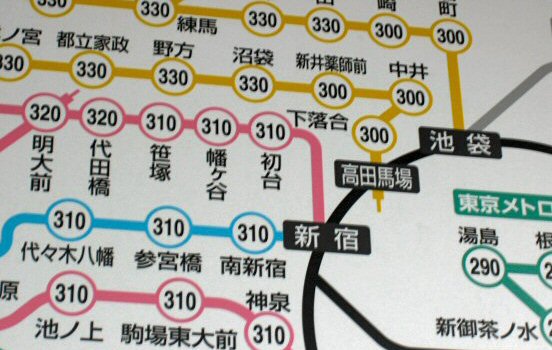 Tokyo subway map. Clear as mud.
Tokyo subway map. Clear as mud.
The next morning I managed to somehow decipher the glyphs of the subway map and a short ride later I walked across the Shibuya crossing, the busiest pedestrian walkway in the world.
 Shibuya crossing.
Shibuya crossing.
A bit further to the north, The Shinjuku station is often considered to be the busiest station in the world. It may be exited in two directions: west and east side, which are as different as black and white.
The 52nd floor of Park Hyatt hides the infamous bar where several pivotal scenes took place in Lost in Translation. I instantly recognized the lamps where Bill and Scarlett once sat. For a relaxing time, make it Suntory time.
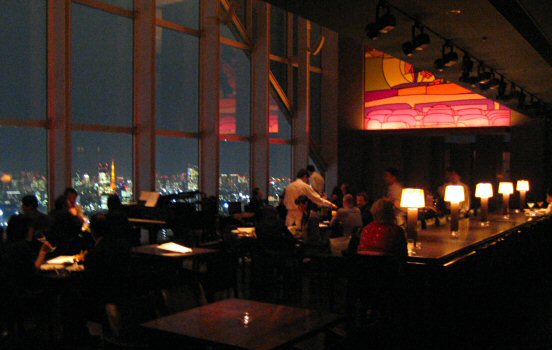 The bar at the 52nd floor of Park Hyatt.
The bar at the 52nd floor of Park Hyatt.
There is only so much one can take of upscale locations, so I decided to explore the eastern part of Shinjuku. I walked around for hours, exploring the small and smelly alleys. The eastern part of Shinjuku is Tokyo’s liveliest night spot and the location of the notorious district Kabukicho.
- Related blog post: Being Godzilla in Tokyo
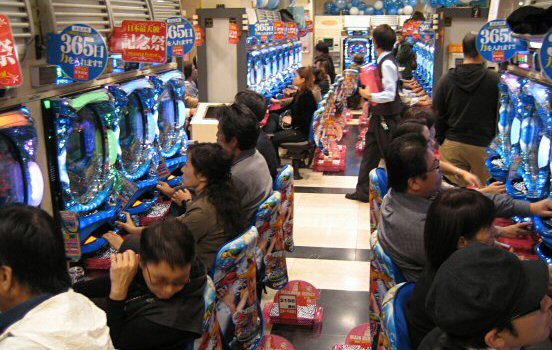 Passing through a noisy Pachinko hall in eastern Shinjuku.
Passing through a noisy Pachinko hall in eastern Shinjuku.
I went to Harajuku and looked for the cosplay assemble at the Jingu-bashi. After this unexpected surge of fresh air I desperately needed caffeine and found a small coffee place. I was the only gaijin in there, so everyone was observing my every move in silent anticipation of what the silly foreigner would do next.
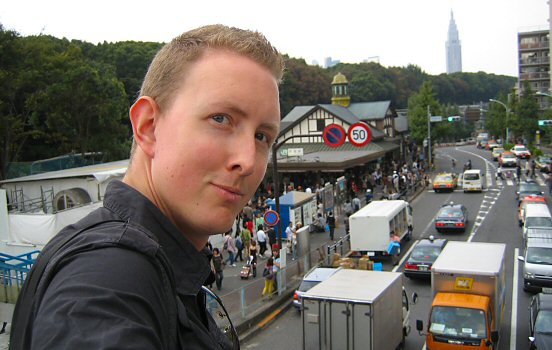 Roaming Harajuku.
Roaming Harajuku.
I walked along the Takeshita-dori, a street with alternative clothing shops which pretty much felt like Camden in London. By now I was getting used to all clerks enthusiastically shouting “Irrashaimasse!” as soon as I entered any shop, an endless chattering while dealing with my purchase and finally the “arigato gozaimashita” on my way out. Annoying in a charming way.
Sayonara Japan
It was time to leave this odd but wonderful country and go west. We were kind of lazy and didn’t want to go back the same way by train, so we got to Narita airport where a Boeing 777 brought us back to Europe.
After a brief stop in Paris we finally arrived in Stockholm on a cold autumn day. Catched a subway to Söder where we stayed at a friend’s apartment. A normal-sized bed felt wonderful and between yawns I noticed that I was still on Japanese time.
A long sleep and a Swedish breakfast, what else is there to wish for? Ah yes, how about another train ride! We went back to Stockholm’s Central Station where we embarked on the last train ride of this journey. The final colors of the autumn trees dashed past the window as the season had come and gone in Sweden without us.
We finally arrived at Gothenburg station in the afternoon, back where we started about seven weeks ago. Our backpacks were a lot more dusty and the shoes slightly worn out, but it was worth it.

5 comments
Leave a reply